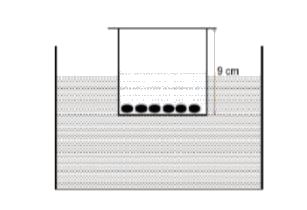A planet of radius Rp is revolving around a star of radius R∗, which is at temperature T∗. The distance between the star and the planet is d. If the planet's temperature is f T∗, then f is proportional to
√R∗/d
R∗/d
R∗RP/d2
(R∗/d)4
The correct Answer is:A
Step by step video, text & image solution for A planet of radius R_(p) is revolving around a star of radius R^(**), which is at temperature T^(**). The distance between the star and the planet is d. If the planet's temperature is f T^(**), then f is proportional to by Physics experts to help you in doubts & scoring excellent marks in Class 12 exams.
Topper's Solved these Questions
Similar Questions
A wide bottom cylindrical massless plastic container of height 9 cm has 40 identical coins inside it and is floating on water with 3 cm inside the water. If we start putting more of such coins on its lid. It is observed that after N coins are put, its equilibrium changes from stable to unstable. Equilibrium in floating is stable if the geometric center of the submerged portion is above the center of mass of the object) The value of N is closed to
 07:05View Solution
07:05View SolutionA planet is revolving around a star in a circular orbit of radius R with a period T. If the gravitational force between the planet and the star is proportional to R^(-3//2) , then
02:56View SolutionA planet is revolving around a very massive star in a circular orbit of radius r with a period of revolution T. If the gravitational force of attraction between the planet and the star is proportional to r−n, then T2 is proportional to
03:31View SolutionA small planet is is revolving around a very massive star in a circular orbit of radius r with a period of revolution. T is the gravitational force between the planet and the star is proportional to r ^(-5//2) ,then T will be proportional to
04:09View Solutionयदि कोई छोटा ग्रह किसी विशाल तारे के चारों ओर R त्रिज्या के किसी वृत्ताकार कक्ष में T परिक्रमण काल के साथ घूम रहा है। यदि ग्रह तथा तारे के मध्य गुरुवीय बल R−5/2 के समानुपाती है, तो T समानुपाती होगा-
View SolutionImagine a light planet is revolving round a very massive star in a circular orbit of radius R with a time period of revolution T. If the gravitational force of attraction between the star and planet is proportional to R^(-n) , then T^2 is proportional to
View SolutionImagine a light planet is revolving round a very massive star in a circular orbit of radius R with a time period of revolution T. If the gravitational force of attraction between the star and planet is proportional to R−n, then T2 is proportional to
View SolutionImagine a light planet revolving around a very massive star in a circular orbit of radius R with a period of revolution T. If the gravitational force of attraction between the planet and the star is proportional to R−5/2, then T2 is proportional to
View SolutionA small planet revolving around a large starting a circulation orbit of radius R with a period of revolution T. The gravitaional force of attraction between the star and the planet is proportional to R32 then T is proportional to
02:44View SolutionA small planet is revolving around a massive star in a circular orbit of radius R with a period of revolution T. If the gravitational force between the planet and the star were proportional to R−5/2, then T would be proportional to
03:13View SolutionA small planet is revolving around a very large star with T rotation period in a circular orbit of radius r. If the gravitational force between the planet and the star r^(5//2) Is proportional to, then T will be proportional to?
02:44View SolutionA small planet is revolving around a massive star in a circular orbit of radius R with a period of revolution T. If the gravitational force between the planet and the star were proportional to R−5/2, then T would be proportional to
View SolutionImagine a light planet revolving around a very massive star in a circular orbit of radius R with a period of
revolution T. If the gravitational force of attraction between the planet and the star is proportional to R−5/2 then07:30View SolutionImagine a light planet revolving around a very heavy star in a circular orbit of radius R whose period of revolution is T. If the gravitational force of attraction between the planet and the star R ^(- (5)/(2)) is proportional to, then:
View SolutionA minor planet is revolving around a very large star in a circular orbit of radius T with a period of revolution. If the gravitational force between the planet and the star r^(-5//2) Then T is proportional to what?
View Solution

